Shortly after the arrival of the Denafrips Athena preamp, I noticed that Vinshine Audio also distributes Kinki Studio products. Further investigation revealed that Kinki Studio makes the EX-P7 preamp which falls in a similar price range and has similar features to the Denafrips Athena. After speaking with Alvin Chee of Vinshine Audio, I arranged to get the Kinki Studio EX P7 preamp in for an evaluation to contrast it to the Athena preamp. Alvin mentioned they get inquiries about the sonic difference between the two units.
A few weeks later, I was summoned to the front door by my wife, who said there was a large box at the front door labeled Kinki Studio, and she was curious what I had ordered. She was relieved to hear that it was an audio component and not what she had conjured up in her mind.
The following is not a full-blown “shoot out” review but more of a report on the different sonic traits of the two pre-amplifiers. Along with my previous Denafrips review, this review should give anyone interested a good feel for the difference.
The Design
The Kinki Studio EX-P7 circuit uses fully discrete input and output stages that are Class-AB biased and yield 16dB gain while employing a precision 127 step switched-resistor ladder volume control for attenuation. The EX-P7 is a single-ended circuit design, so the XLR inputs and outputs found on the unit are more of an interface convenience than an indication of the internal circuitry.
The circuitry is enclosed in a very substantial 28lb chassis that uses an 8-10mm thick CNC machined anodized aluminum case, offered in silver or black. This design reduces the impact of EMI from surrounding equipment. Kinki Studio then takes that one step further by individually encasing the two power transformers to lessen any effect on the internal circuitry. Using one each for the Left and Right channel power supplies to improve the separation makes the EX-P7 essentially a dual mono design.
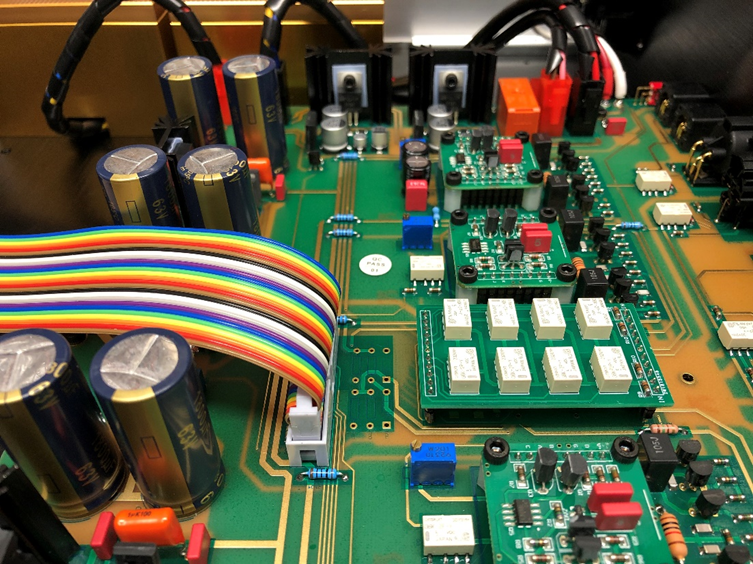
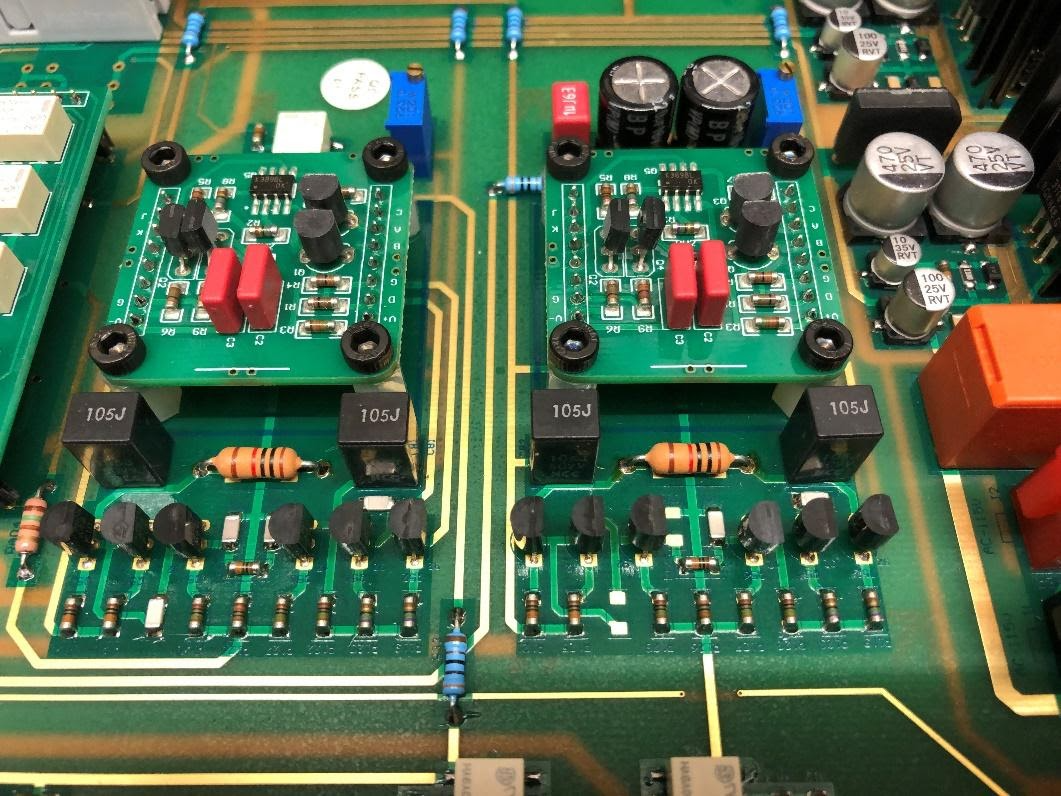
Construction is modular with an eye on upgrades and serviceability. The EX-P7 has 0.2µm gold-plated circuit board traces with an increased soldered area at each solder joint. The above pictures show the individually mounted discrete gain stages with the two rectangular red Wima capacitors and the volume control module with the eight white relays. Should there be an upgrade or failure with the gain modules or volume control, the customer can simply unplug the module and replace it.
With an input/output impedance of 50K ohms and 75ohms, respectively, the EX-P7 should play well with other components attached to it.
The Component
The two large knobs dominate the front panel for input selection and volume control. The center window for the sizeable dot-matrix display shows the selected input and the volume level. Both knobs have a silky-smooth feel with just the right amount of resistance that gives it a high-end sense. The display illumination is adjustable with three settings via the remote. High, low, and off. If you select “off,” only a single dot in the display will be left on in place of a power indicator. The display will come on when you change volume, input, mute, etc., to see what setting you have chosen. Then, after about 5 seconds, it turns back off. “Off” is unquestionably my favorite configuration of a display, and I wish more manufacturers offered it.
Speaking of remotes, if you have followed my reviews, you know I am pretty picky about remotes and have given several manufacturers poor marks for theirs. If any manufacturers need some help designing a better remote, they need to look no further than Kinki Studio. The included remote is one of the best designs I have used.
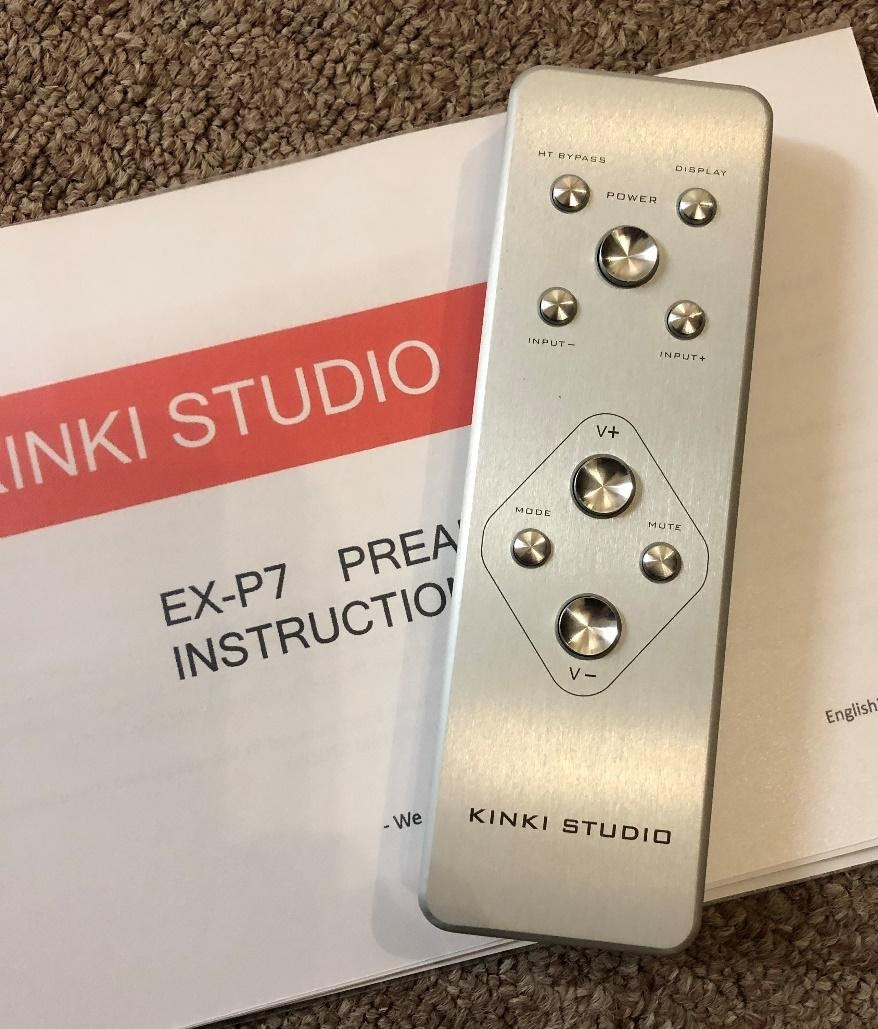
Made of anodized aluminum, the remote is the perfect size for the hand. The feel of it exudes quality. Logically grouped buttons and the three most used buttons being more prominent than the rest make the remote very easy to use in a dark room.
The icing on the cake is the magnetically attached rear door. To change the battery, you can simply pop open the door with your fingernail to access the battery. Brilliant!
Moving to the rear of the unit we see the three mirrored inputs and outputs (RCA inputs x2, XLR x 1) along with the IEC power connector and fuse holder. And the master power switch. One final feature offered on the rear of the unit is a Hi or Lo gain switch that allows you to match the gain range to your amplifier.
The Hookup
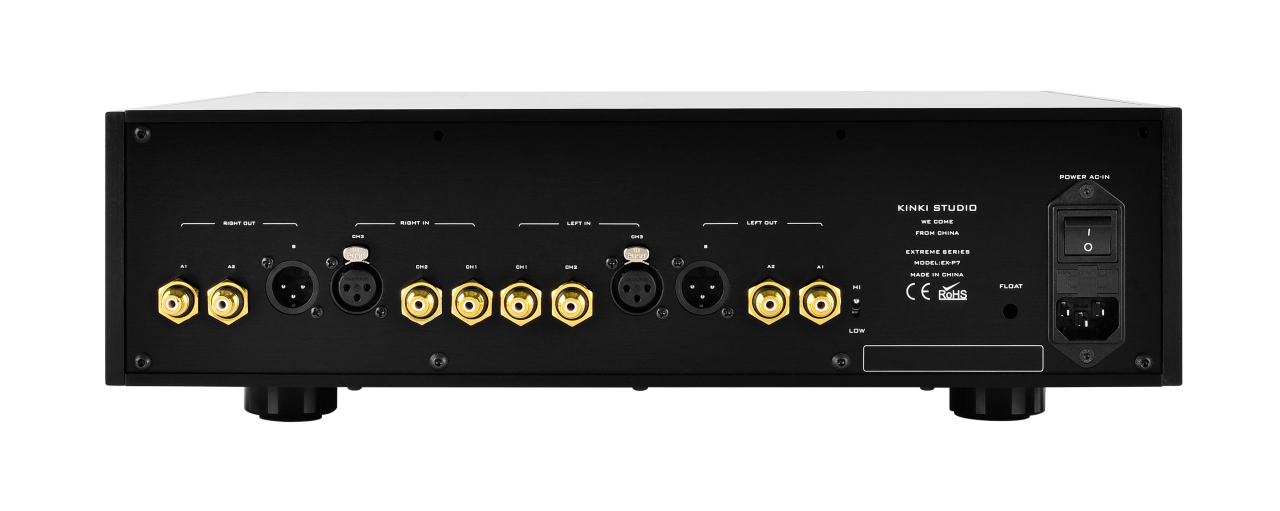
The Kinki Studio EX P7 replaced the Denafrips Athena preamp that I have had in the house for a few months. The other components with my digital front-end remained the same, the PS Audio SACD transport, Denafrips Terminator Plus DAC, and ROON Nucleus. My analog front-end consisted of an AMG Viella V12JT turntable using the DS Audio Master One cartridge.
Amplifiers used with the EX P7 were the PS Audio M1200 monoblocks, Kinki Studio EX M7, and my Quicksilver MS190 tube amplifier.
These combinations were run with SE cables from the preamp to the amplifier.
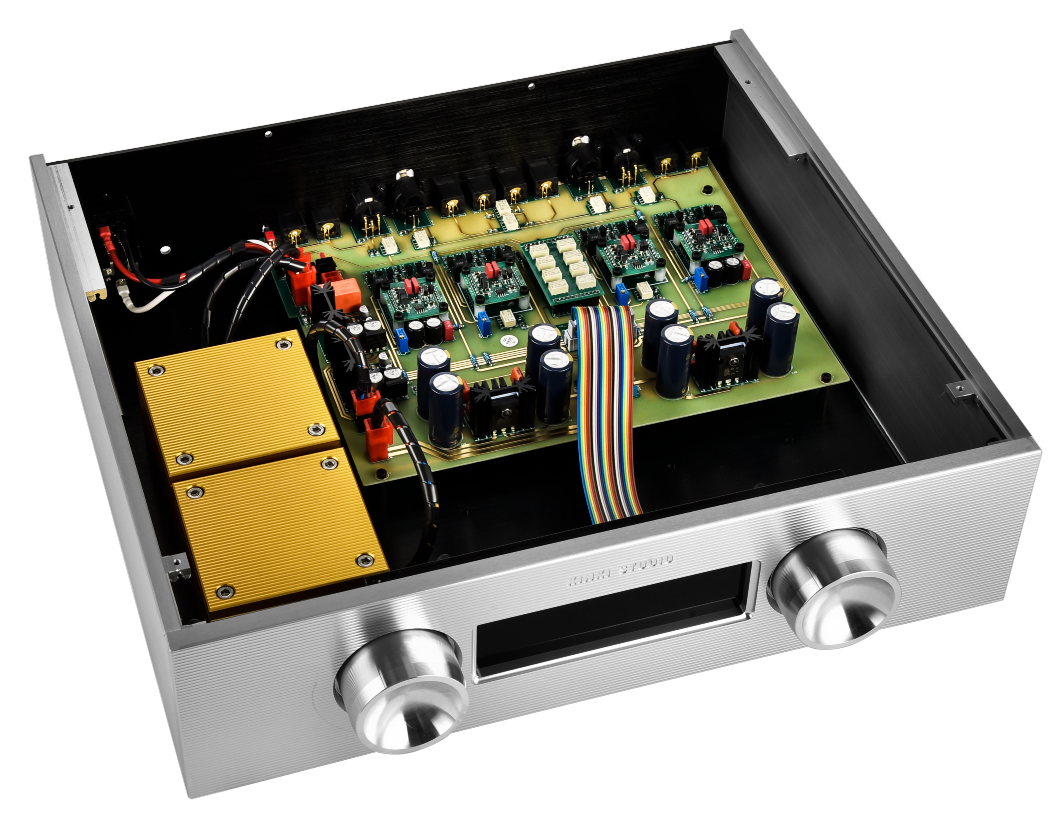
Listening notes
Right out of the gate it sounded like someone had put a new set of tires on a Formula One car. Speed and agility became more apparent, and the overall drive and handling of the music were more surefooted. I am not trying to disparage the engaging sound of the Athena. I mean to point out that while the Athena preamp builds the music from the midrange on out, the EX P7’s focus is on speed, exactness, and linearity.
These qualities further exhibited themselves as I tried the EX P7 with the previously mentioned amplifiers.
When used with the PS Audio M1200 amplifier, the overall sound was too analytical for my taste. The Athena, with its full-bodied midrange, slightly rounded leading edge, and transient presentation, matched better with the PS Audio M1200s.
Next, I paired the EX P7 with its matching Kinki Studio EX M7 amplifier and heard what I think would be an excellent pairing for the listener, with a focus on speed, transparency, and detail. This combination offered an incisive dissection of the music with a superb resolution of low-level detail and soundstage information.
Finally, I tried the EX P7 with my Quicksilver MS190 and got what I thought was the best combination. A great example of a random but magical combination is a solid-state preamp driving a tube amplifier. The exactness, speed, and top to bottom linearity of the EX P7, when combined with the magical midrange of the Quicksilver, proved a winning combination to my ear.
Compared to the Athena preamp, it was evident that the EX P7 was more linear, faster, and more agile but ultimately lacked a bit of density in the lower midrange and left me wanting in that area.
The takeaway is, while all five of the components mentioned can stand on their own, it is the correct combination of components that delivers the goods.
Let’s spin a few…
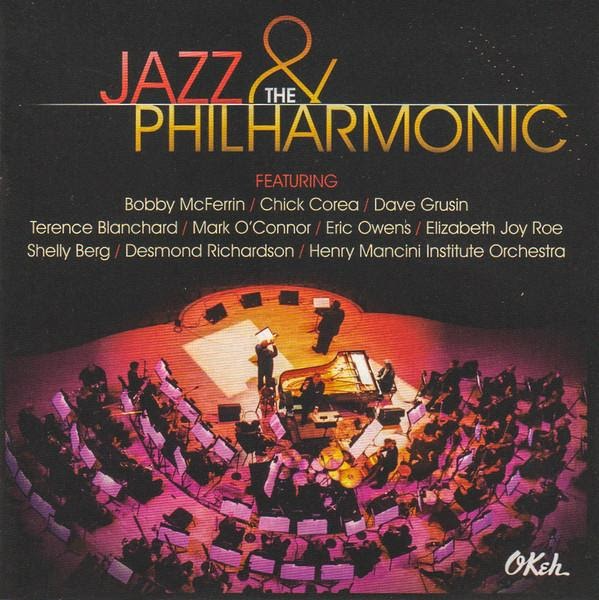
An outstanding disc that offers up excellent performances by some Jazz greats combined with the Terrance Blanchard directed Henry Mancini Institute Orchestra.
My go-to cut is Fugue in C Minor, featuring Eric Owens and Terrance Blanchard.
The tremendous opening vocal is well served by the EX P7, as is the recreation of the hall, ie, the recording environment. Terrance Blanchard’s trumpet and the scale of the orchestra are exceedingly well rendered. On the next cut, Spanish Suite, Chick Corea’s piano has all the speed, attack, and clarity you expect.
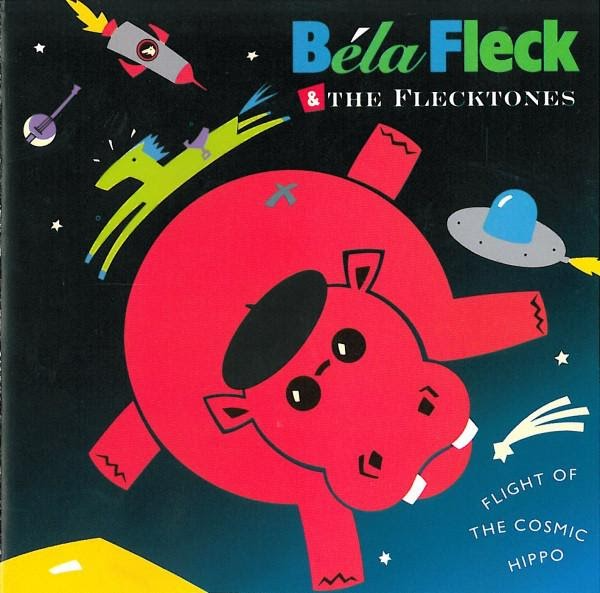
I threw the infamous Flight of the Cosmic Hippo at the EX P7, and it passed admirably. Mind you; this cut explores some subterranean notes. The EX P7 surpassed the Athena in this area of bottom octave reproduction. It was quicker and tighter and with less overhang than the Athena.
As I continued to listen to other albums and thought about the differences between the Athena and the Kinki Studio preamps, I recalled the first few times back in the ‘80s that I heard Japanese artists playing American Jazz. While the instruments were played with undeniable technical expertise, the overall feeling of the music had less emotion than I was accustomed to from the American artist.
The new EX P27 preamp, while at a $1,000 higher price point, will be very interesting to listen to. The first feature noted on the Kinki Studio’s website says it has “a new version of PCB board, it is improved with more full-body mid-range sound.” Perhaps it will be the melding of technological excellence of the EX P7 and artistry of the Athena and prove to be the “goldilocks” combination. I hope to have an EX P27 in the first half of 2022 and report to you.
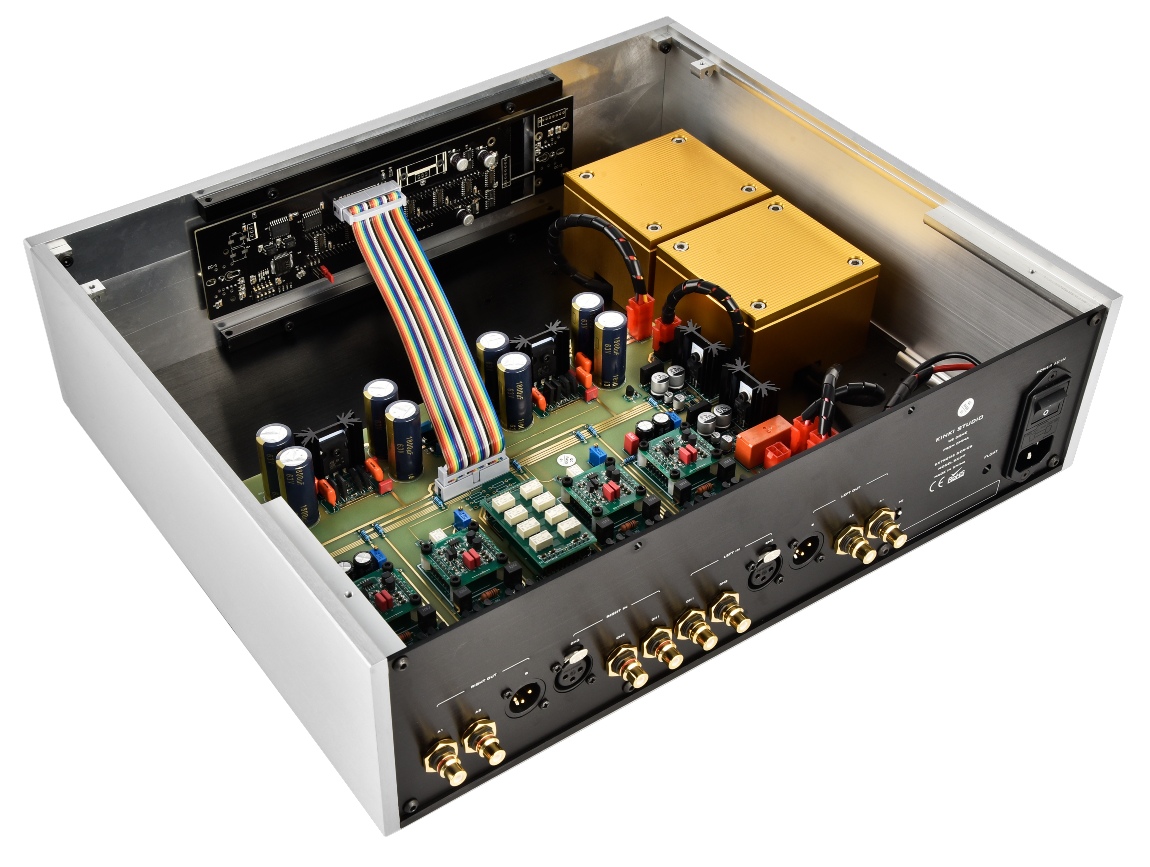
Conclusion
Rest assured that in the EX P7, you are getting a beautifully executed preamp at a very competitive price point.
With its attributes of speed, low noise, vanishing grain, and purity, the EX P7 offers what most would describe as a “truthful” conveyor of the signal it is fed. I can find no genuine fault technically, and in the end, I found that the EX P7, when paired with sympathetic components, could be your friend. Examples would be Transparent Audio or Cardas cables and Sonus Faber or Harbeth speakers.
On the other hand, the Athena will pair up nicely with cables from the likes of Analysis Plus or WyWires and speakers like Magico or Focal. In the end, both preamps are well-executed products that come at the music from slightly different angles.
Is one better than the other? It will depend on your “on buttons.” Two listeners I invited over for a listening session preferred the EX P7. My preference is for a sound that focuses on density and a deeper color in the midrange, and I am willing to give up a bit of speed to have it, so the Athena was my pick. And that, my friends, is what makes this hobby so fascinating.
What I can tell you is that if your preference is for something that excels in technical correctness, you will be hard-pressed to find a product that offers the combination of build quality and sonic performance that the EX P7 offers at its price point.
About Kinki Studio
When I asked Ken Ng, who heads up Kinki Studio, for a bit of background on the company that was started in 2007, he provided the following.
“The company’s designer Ivan Liu was born and raised in a military products manufacturing district in Guangzhou. The military factory mainly produces radar communications equipment for military vessels but also consumer audio. He enjoyed many opportunities to get in touch with related technical personnel and to obtain military parts to conduct his research. With these influences, he later focused on electronics-related disciplines in high school and university.
With the formation of Kinki Studio, he set the requirements for product tech very high. His designs were informed by studying world-class audio products. With the knowledge acquired, he then adopted reasonable optimizations for his own. His core design concepts are circuit minimalism with shortest signal paths to ensure the restoration of the signal rather than add unnecessarily circuits that can alter the signal. He also believes that audio components aren’t just electrical devices but also ornamental art. Therefore the electrical design process and the final appearance must be considered as a whole.
I am a partner of Alvin Chee which under Vinshine Audio, we started to cooperate with Ivan Liu and established Kinki Studio Pte Ltd in Singapore on 20 April 2019 to expand our business network worldwide. Vinshine Audio is now the representative of Kinki Studio for global market sales except for Hong Kong, Taiwan, and China Mainland which is solely under the control of Ivan Liu. Currently, we have almost 22 appointed distributors.”
Kinki Studio EX P7: $1,998 at the time of this review.

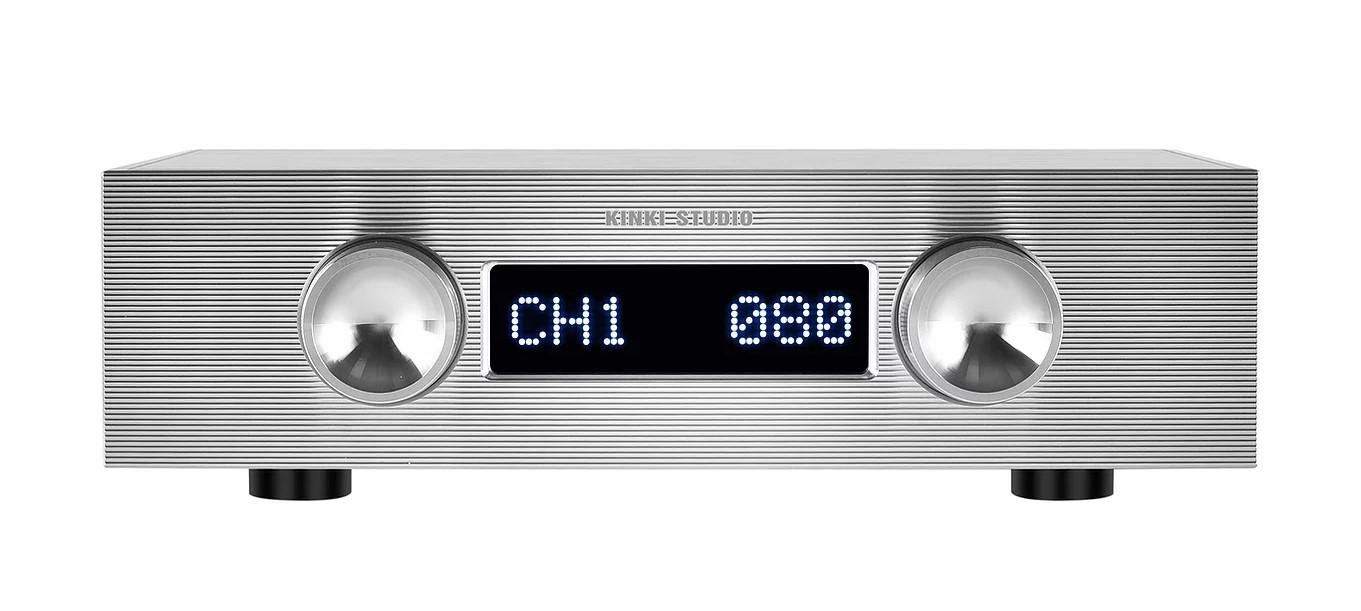
Spot on review. I have the Kinki P27 and Kinki monoblocks. Wonderful with my Harbeth speakers but not so much with my new Magico A5 speakers. Midrange lacks body which the Harbeth had in spades. Fortunately, I have a LM508IA when I tire of the Kinki but it takes a while to warm up.
Thanks for taking time to share your experience. I bet that Kinki/Harbeth combo is special.
Component synergy is the “secret sauce” in Audio.
Just came across this post now. My long-gone Harbeths were HP5+. I think that these are listenable with most front end gear but lacked detail. I especially missed cymbals and snare drums. The Magico A5 speakers are very detailed as is Kinki Audio gear. Well recorded disks/files and almost all vinyl sounds fantastic but transparency means you may hear all the warts, limiting what you will listen to.
So if i understand well it is a great match with harbeth speakers? I own the 30.1 types and i am wondering what types of harbeths you have
Hi Edwin… The comment about the Harbeths and Vandersteen speakers was meant to offer a reference to a type of speaker the Kinki Studio EX-P7 would synergize with. I felt it would match well with a speaker that is not overly analytical and leans toward to slightly warmer side of neutral. I do not personally own Harbeths but, over the years, I have had a lot of listening experience with them and have a lot of respect for them. You could also add the Graham Loudspeakers to that list ….Hope this answers your question.
Quote: I hope to have an EX P27 in the first half of 2022 and report to you.
Your report would be highly appreciated
Greetings and thanks for your inquiry…
Unfortunately … I was not able to secure an EX P27 for review.
thanks for the excellent review Ken ,
Can I kindly ask you which one did you end ip liking best :
Athena or the EX-P7 ?
Cheers !